highlights
about action
action in 2022
sustainability
people
planet
product
partnership
future
governance
appendix
Planet

We are aware that our activities as a retailer contribute to climate change through emissions of greenhouse gasses and consumption of natural resources. In our previous Update we stated that we are striving to reduce the emissions from our own operations by 50% by 2030. We now commit to reducing the emissions from our own operations by 60% by 2030 (versus the 2021 baseline).
Hence, decreasing the impact we have on the environment, people, and future generations.
Planet pillar strategy and ambition
Action works strategically towards lowering our negative impact on the environment. The Planet pillar focusses on energy, emissions and waste management. Moreover, this year we started working with the TCFD framework (The Taskforce on Climate-related Financial Disclosures (TCFD)), to gain insight into potential climate change risk on our business operations. We are also looking at our potential for scope 3 and we are proud to announce that we have entered a collaboration with our biggest logistics partner Maersk. For 2023, we signed a contract to lower our emissions through Maersk’s ECO Delivery programme. This programme replaces the use of fossil fuels with ISCC certified green fuels for overseas transport, which will result in a reduction in scope 3 emissions by 29,000 tons of CO2 next year.
Perhaps you have spotted a fully electric Action truck on the road. Since the beginning of 2023, we have operated two fully electric trucks for daily deliveries to our stores. The trucks depart from our distribution centre in Echt in the Netherlands. In March 2023 a third and a fourth E-truck were added operating out of the Action-DC in Biblis, Germany. All four trucks are part of a pilot for implementing electrical transport in our logistic process.
Pilots sustainable transport


Read more

In 2022, we lowered our energy use, increased our share of renewable energy and introduced HVO biodiesel for our self-owned trucks. As a result, our scope 1 and 2 CO2 emissions were reduced by 40%.
We want to reduce our environmental impact and work towards a resilient and climate change proof Action.
Highlights



for our stores, DCs and offices in 2022.
green renewable energy
90%
Pilots with 2 electric trucks carried out for our DCs in Echt (NL) and 2 in Biblis (GE).
electric trucks
4
achieved by our newly opened DC in Ensues-la-Redonne (France).
Excellent status
BREEAM
are now disconnected from gas (85% of our store base).
stores
1,900+
of scope 1 and 2 emissions achieved in 2022 versus 2021 baseline.
reduction
40%
Solar panel systems at DC Zwaagdijk (NL), Bieruń (PL) and Verrières-en-Anjou (FR).
panel systems
Solar
were fitted with LED lights in 2022.
of our stores
95%
Commitment to reduce emissions from our own operations (scope 1 and 2) by 60% by 2030, versus the 2021 baseline.
reduction
60%


Energy use and emissions
Direct and indirect energy consumption and emissions are part of Action’s contribution to climate change. The Planet pillar’s main focus is to mitigate and remediate this negative impact by reducing emissions of greenhouse gasses (GHG).
Our commitment is to reduce Action’s absolute emissions from our own operations by 60% in 2030 (baseline 2021). We started with scope 1 and 2 for our strategic focus, and are in the process of calculating our scope 3 emissions and determining our targets and reduction strategies.
Strategic objective
Management of material topic
We manage our CO2 emissions per scope which requires close collaboration with multiple departments, such as Supply Chain, Real Estate, Facility Management, Transport, Procurement and Store operations, as well as external partners like suppliers, and logistics service providers.
Progress made
This year we significantly reduced our gas consumption (scope 1) by disconnecting another 128 stores from gas. At the moment, we still have 330 stores connected to gas for heating and our target is to have all stores disconnected from gas by the end of 2024. We are well on our way to achieving that goal.
In 2022, we reduced our scope 1 and 2 CO2 emissions by 40%, and we purchased renewable energy as much as possible. 90% of our electricity consumption was renewable and our targeted energy efficiency programme helped us to reduce energy consumption per store by 10%.
Alternative transport
Action reduced its transportation emissions from our own trucks by 13%. We achieved this by introducing HVO biodiesel instead of regular diesel to fuel ten of our trucks at the DC in Zwaagdijk (NL). In the past few years, we saw an increase in our energy consumption and emissions of transport due to our rapid growth. Biofuels, such as HVO, are an important interim solution to significantly reduce CO2 emissions in the short term. The CO2 reduction is substantial (up to 90%) and implementation on a short term and large scale is feasible. That makes this pilot especially valuable and we are happy with the results. In 2023, we will implement a full roll-out to all our 150 self-owned trucks in the DCs in Zwaagdijk and Echt (NL).
In the longer term, Action will phase HVO out by introducing electric or hydrogen trucks. We initiated pilots in 2023 with electric trucks in our DCs: two trucks in Echt (NL), and two in Biblis (GE). The purpose is to gain experience, and learn how we should implement the further roll-out of electric transport.
Renewable energy
In scope 2, we have also achieved a substantial reduction of emissions by moving towards green (renewable) energy sources. We have full renewable electricity in the Netherlands, Belgium, Luxembourg, France, Germany, Austria and Slovakia. In Poland, the Czech Republic, Italy and Spain our energy transition is slower because for many properties we depend on landlords. We installed solar panels on the roofs of our DCs in Bieruń (PL, 500 kW) and Verrières-en-Anjou (FR, 4.2 MW) in 2022, in addition to the solar panels at our DC in Zwaagdijk (NL) and on the roofs of 54 stores. In 2022, 90% of the electricity we used was renewable (offices and DCs 86%, stores 90%). In 2022, the solar panels on the roofs of our DCs generated 12,836,411 kWh of renewable energy, which equates to 55% of the total electricity usage of all our DCs (23,285,667 kWh ).
In the previous year (2021), the solar panels on the roofs of our DCs generated 2,176,838 kWh.
Lowering our energy use
Action also took another step in the reduction of usage by installing energy efficient LED-lights. Currently, 95% of our stores have LED-lights (2,206 stores) and the other 5% will get LED lights at the start of 2023. Moreover, more than 1,700 stores are now connected with smart meters to our energy portal, which will help us to analyse our consumption data and to optimise our usage in 2023.
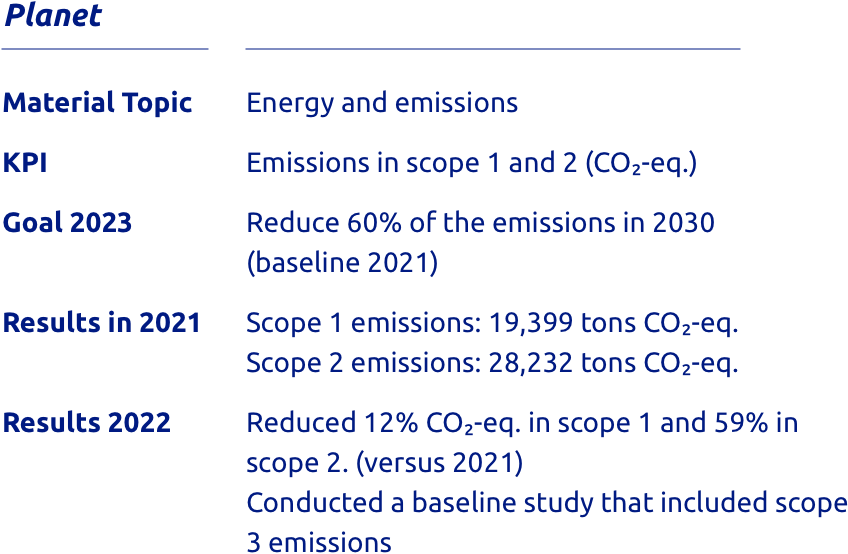
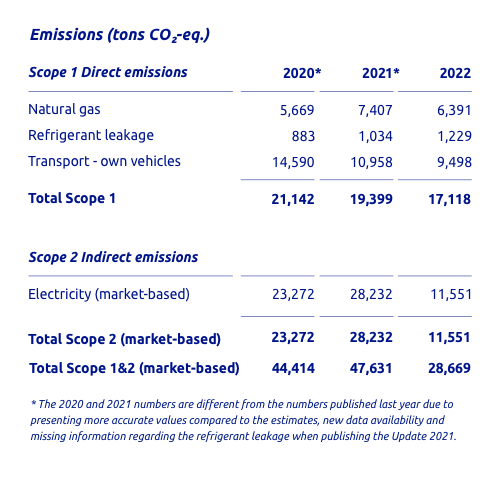
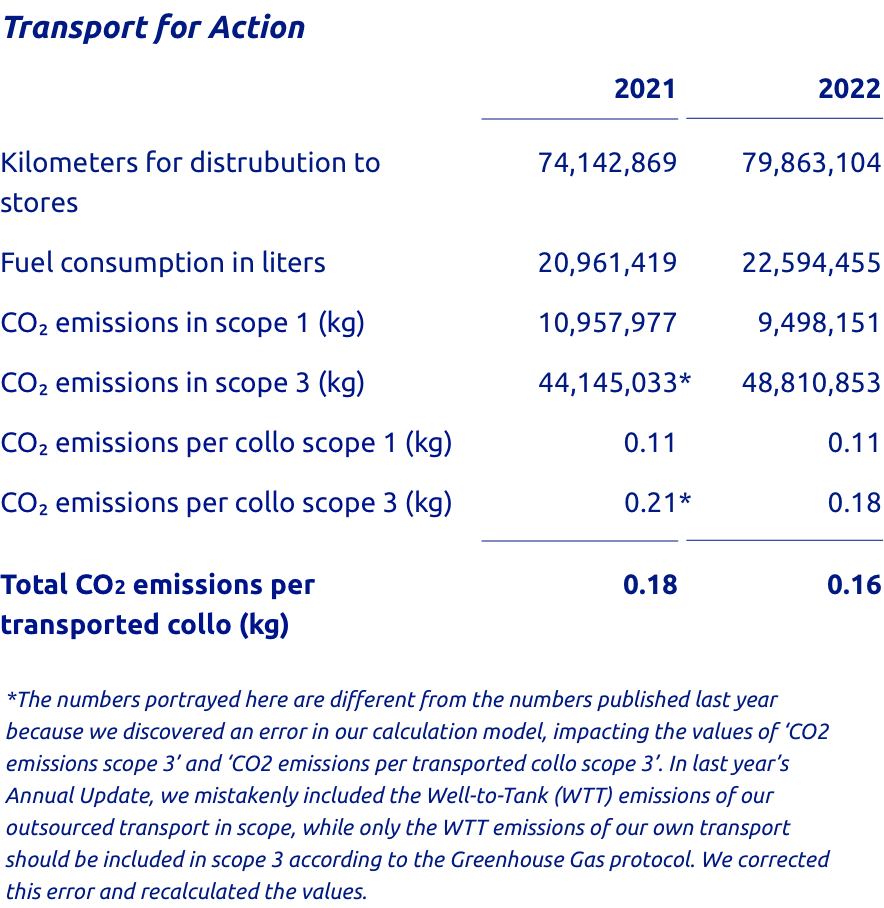
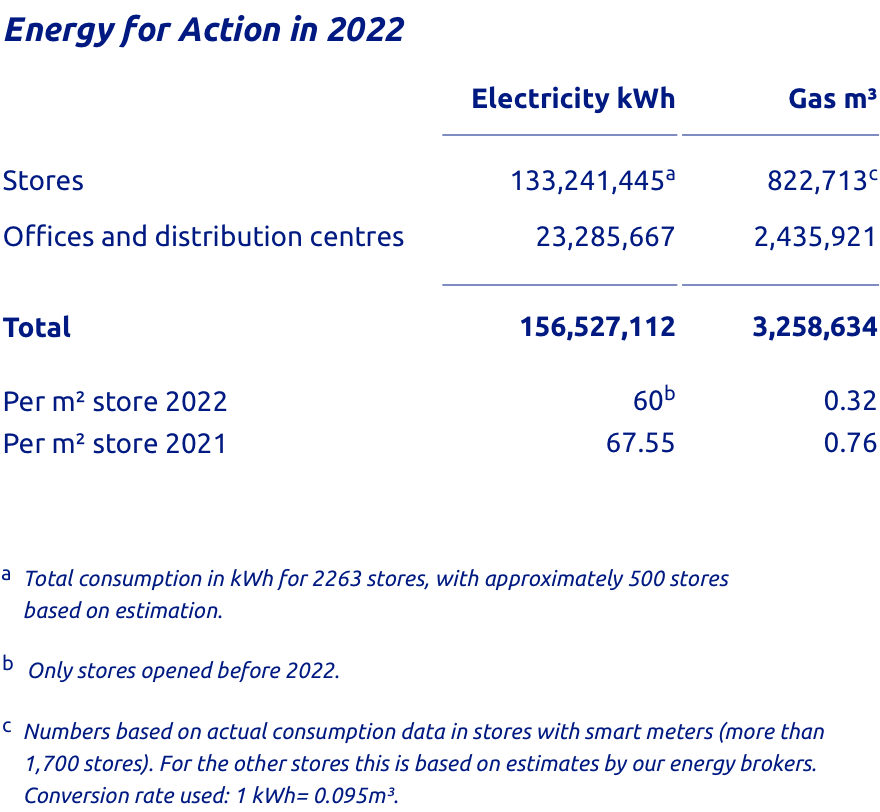
Hajir Hajji and Edward Stigter
Action commissions 12,700 solar panels at IHQ/DC Zwaagdijk

Read more
Solar panels DC Zwaagdijk

On Friday 23 September, Action CEO Hajir Hajji commissioned a solar roof comprised of almost 13,000 panels at the IHQ/distribution centre in Zwaagdijk-Oost alongside Edward Stigter, Deputy Minister for the Environment and Climate in the province of Noord-Holland, the Netherlands.
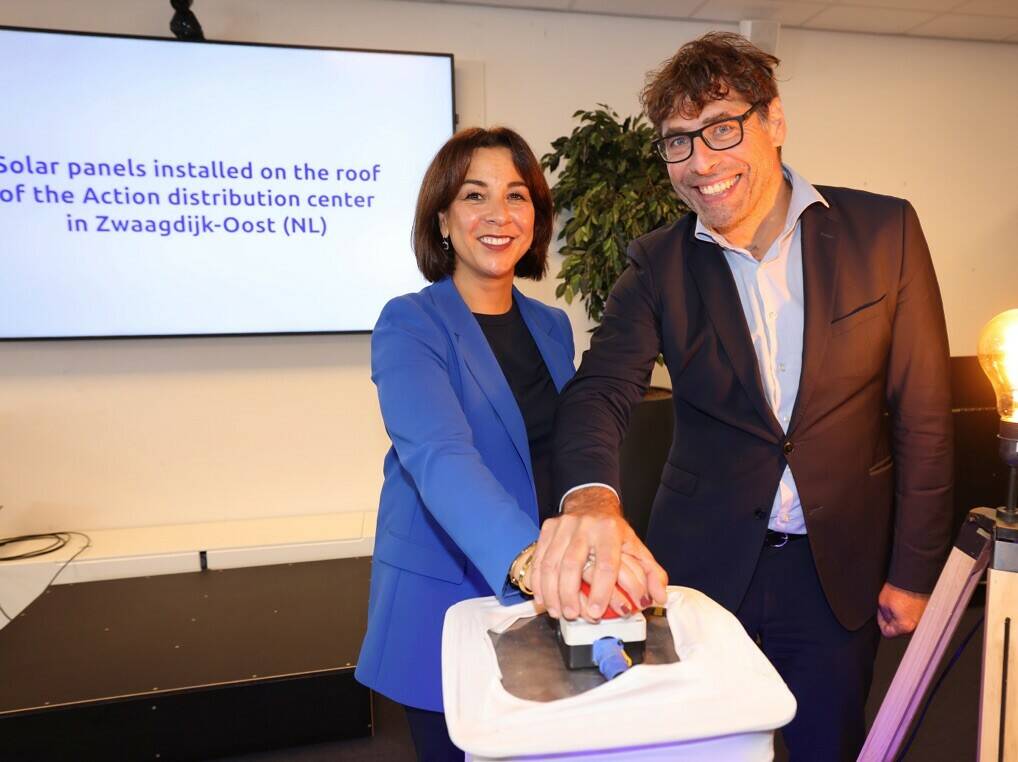
Action started in 2022 with mapping its total scope 3 emissions, from raw materials to end-of-life treatment of products. After validation of the data by an external party, we will use the results to determine CO2 reduction targets for scope 3 and to formulate a scope 3 reduction strategy.
Next steps
In 2022, Action decided to implement HVO for all our own trucks (150) that deliver to stores from our Dutch DCs. We decided to install a ‘home-base’ solution in our DCs. Unfortunately, the permit process has taken longer than anticipated, and the installation lead times have been delayed. We expect a full roll-out in 2023.
We have also planned to install solar panels on the roofs of five stores in Austria. We are currently working on the expansion of the number of solar panels on stores, often in consultation with our landlords. In 2023 we will install solar panels on the roofs of our DCs in Ensues-la-Redonne in France, Zakroczym in Poland, and Novara in Italy.
We aim to increase the use of green electricity to 95% for the total of our stores, DCs, and offices, and to reduce energy consumption in stores by at least another 5% per m2. This will be achieved mostly by optimizing the settings of heating, ventilation and air conditioning (HVAC), improving insulation of stores (where applicable), adjusting light settings to store opening hours and analysing the smart meter data of high consuming stores. All this will contribute to our target to reduce energy consumption in our stores by 15% per m2 by 2024 versus the 2021 baseline.
In addition, we are in the process of calculating our scope 3 emissions and determining our targets and reduction strategies.
Remaining targets
Monitoring and evaluation
Action monitors and calculates its CO2 emissions according to the Greenhouse Gas protocol (GHG-protocol). The GHG-protocol is the most recognised and accepted method to calculate emissions. It is a required benchmark to comply with regulations for non-financial reporting (CSRD) and sustainability reporting standards GRI and SASB. In our calculations and communications, we use both ‘Emissions’ and ‘CO2 equivalent emissions’. Both also include other greenhouse gasses such as methane and HFCs, not only CO2.
In 2022, Action set a new CO2 emission target: reduce scope 1 and 2 by 60% by 2030 relative to the 2021 baseline. The CO2 emissions of the previous baseline year (2020) were only calculated for scope 1 and 2. By changing to 2021, we are able to add scope 3 to the baseline calculation, as 2021 is a more recent year, with better availability (completeness and quality) of data. The actual emissions for scope 1 and 2 in the new baseline year 2021 are higher than in the previous baseline year 2020 (47,631 ton versus 44,414 ton). By simultaneously increasing the reduction target from 50% to 60%, our total CO2-reduction task is getting bigger, and the remaining CO2 emissions in 2030 lower.
We collaborate with all relevant partners like landlords, transport truck manufacturers, installing companies, building companies and energy providers to realise our ambitions to reduce absolute emissions from our own operations.
The role of stakeholders


Continue reading
Action’s waste strategy is focused on the correct separation of current waste streams and reducing remaining residual waste. This means that better standardisation of the sorting process is needed in our DCs and training of our employees, especially in the Returned goods department. Our ambition is to start annual audits with business partners on waste processing.
Waste management and recycling

TCFD results

Continue reading
Action is now at the beginning of a journey to deepen the understanding of, and response to, climate change. This year we started working with the framework from The Taskforce on Climate-related Financial Disclosures (TCFD) to embed climate-related risk in our ASP strategy.
Previous page

Product
Next page


People
Planet

We are aware that our activities as a retailer contribute to climate change through emissions of greenhouse gasses and consumption of natural resources. In our previous Update we stated that we are striving to reduce the emissions from our own operations by 50% by 2030. We now commit to reducing the emissions from our own operations by 60% by 2030 (versus the 2021 baseline).
Hence, decreasing the impact we have on the environment, people, and future generations.
Planet pillar strategy and ambition
Action works strategically towards lowering our negative impact on the environment. The Planet pillar focusses on energy, emissions and waste management. Moreover, this year we started working with the TCFD framework (The Taskforce on Climate-related Financial Disclosures (TCFD)), to gain insight into potential climate change risk on our business operations. We are also looking at our potential for scope 3 and we are proud to announce that we have entered a collaboration with our biggest logistics partner Maersk. For 2023, we signed a contract to lower our emissions through Maersk’s ECO Delivery programme. This programme replaces the use of fossil fuels with ISCC certified green fuels for overseas transport, which will result in a reduction in scope 3 emissions by 29,000 tons of CO2 next year.
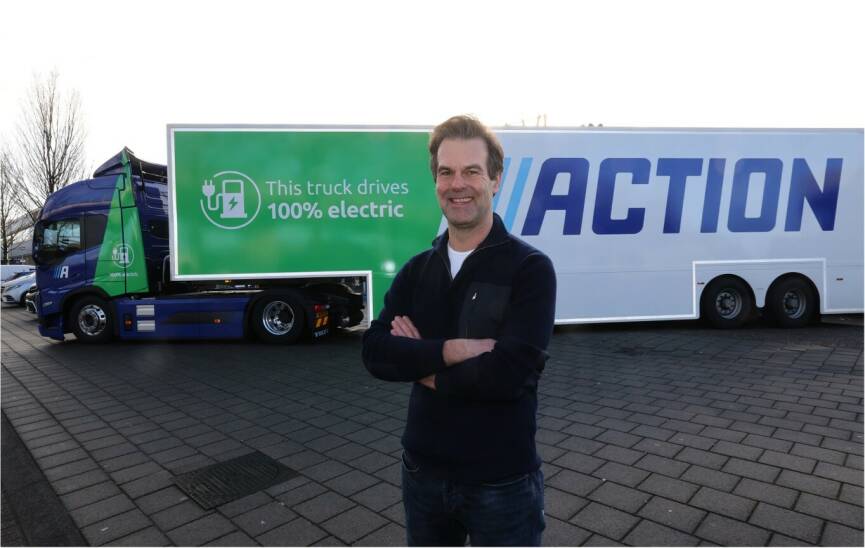
Pilots sustainable transport

Perhaps you have spotted a fully electric Action truck on the road. Since the beginning of 2023, we have operated two fully electric trucks for daily deliveries to our stores. The trucks depart from our distribution centre in Echt in the Netherlands. In March 2023 a third and a fourth E-truck were added operating out of the Action-DC in Biblis, Germany. All four trucks are part of a pilot for implementing electrical transport in our logistic process.

Read more
In 2022, we lowered our energy use, increased our share of renewable energy and introduced HVO biodiesel for our self-owned trucks. As a result, our scope 1 and 2 CO2 emissions were reduced by 40%.
We want to reduce our environmental impact and work towards a resilient and climate change proof Action.
Highlights

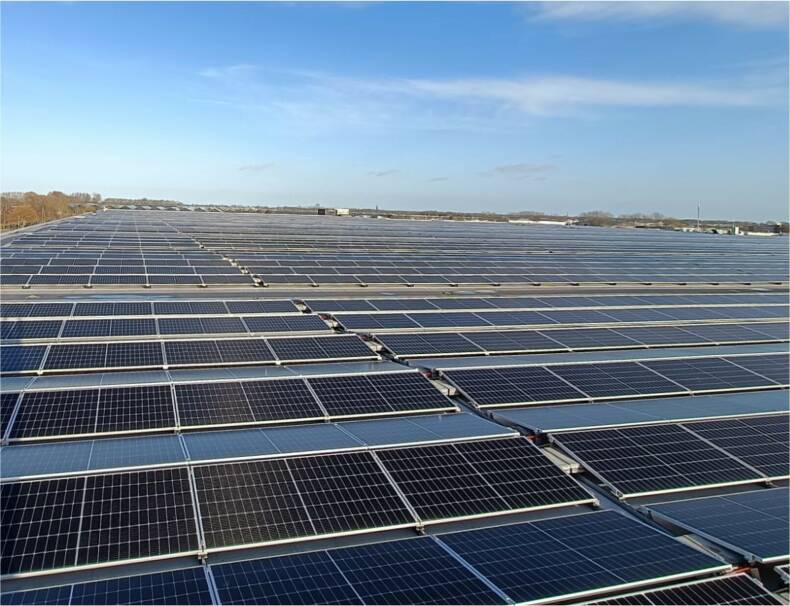
Commitment to reduce emissions from our own operations (scope 1 and 2) by 60% by 2030, versus the 2021 baseline.
reduction
60%
of scope 1 and 2 emissions achieved in 2022 versus 2021 baseline.
reduction
40%
are now disconnected from gas (85% of our store base).
stores
1,900+
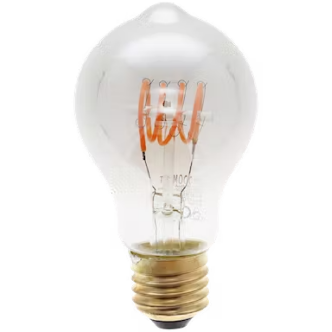
for our stores, DCs and offices in 2022.
green renewable energy
90%
were fitted with LED lights in 2022.
of our stores
95%
Solar panel systems at DC Zwaagdijk (NL), Bieruń (PL) and Verrières-en-Anjou (FR).
panel systems
Solar
achieved by our newly opened DC in Ensues-la-Redonne (France).
Excellent status
BREEAM

Pilots with 2 electric trucks carried out for our DCs in Echt (NL) and 2 in Biblis (GE).
electric trucks
4
Energy use and emissions
Direct and indirect energy consumption and emissions are part of Action’s contribution to climate change. The Planet pillar’s main focus is to mitigate and remediate this negative impact by reducing emissions of greenhouse gasses (GHG).
Our commitment is to reduce Action’s absolute emissions from our own operations by 60% in 2030 (baseline 2021). We started with scope 1 and 2 for our strategic focus, and are in the process of calculating our scope 3 emissions and determining our targets and reduction strategies.
Strategic objective
Management of material topic
We manage our CO2 emissions per scope which requires close collaboration with multiple departments, such as Supply Chain, Real Estate, Facility Management, Transport, Procurement and Store operations, as well as external partners like suppliers, and logistics service providers.
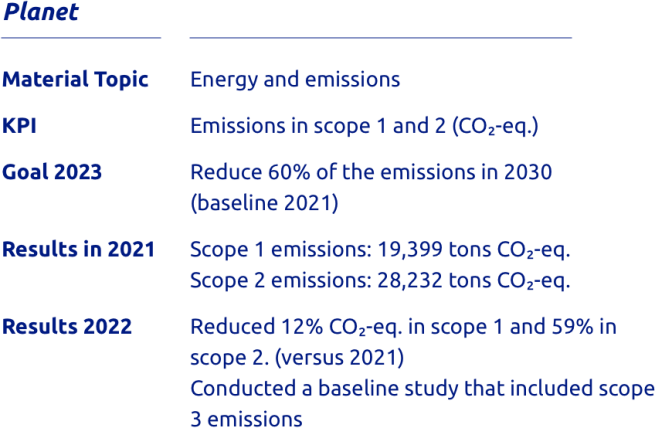
Progress made
This year we significantly reduced our gas consumption (scope 1) by disconnecting another 128 stores from gas. At the moment, we still have 330 stores connected to gas for heating and our target is to have all stores disconnected from gas by the end of 2024. We are well on our way to achieving that goal.
In 2022, we reduced our scope 1 and 2 CO2 emissions by 40%, and we purchased renewable energy as much as possible. 90% of our electricity consumption was renewable and our targeted energy efficiency programme helped us to reduce energy consumption per store by 10%.
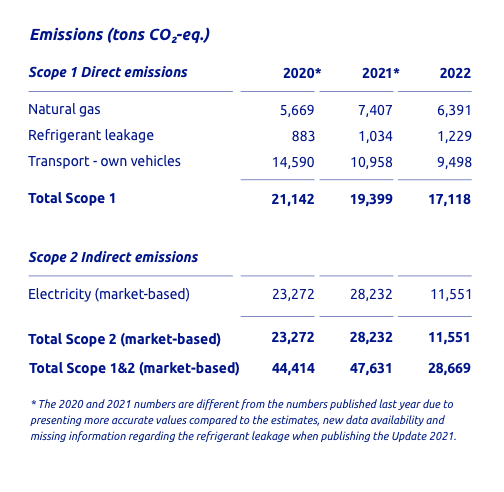
Alternative transport
Action reduced its transportation emissions from our own trucks by 13%. We achieved this by introducing HVO biodiesel instead of regular diesel to fuel ten of our trucks at the DC in Zwaagdijk (NL). In the past few years, we saw an increase in our energy consumption and emissions of transport due to our rapid growth. Biofuels, such as HVO, are an important interim solution to significantly reduce CO2 emissions in the short term. The CO2 reduction is substantial (up to 90%) and implementation on a short term and large scale is feasible. That makes this pilot especially valuable and we are happy with the results. In 2023, we will implement a full roll-out to all our 150 self-owned trucks in the DCs in Zwaagdijk and Echt (NL).
In the longer term, Action will phase HVO out by introducing electric or hydrogen trucks. We initiated pilots in 2023 with electric trucks in our DCs: two trucks in Echt (NL), and two in Biblis (GE). The purpose is to gain experience, and learn how we should implement the further roll-out of electric transport.

Renewable energy
In scope 2, we have also achieved a substantial reduction of emissions by moving towards green (renewable) energy sources. We have full renewable electricity in the Netherlands, Belgium, Luxembourg, France, Germany, Austria and Slovakia. In Poland, the Czech Republic, Italy and Spain our energy transition is slower because for many properties we depend on landlords. We installed solar panels on the roofs of our DCs in Bieruń (PL, 500 kW) and Verrières-en-Anjou (FR, 4.2 MW) in 2022, in addition to the solar panels at our DC in Zwaagdijk (NL) and on the roofs of 54 stores. In 2022, 90% of the electricity we used was renewable (offices and DCs 86%, stores 90%). In 2022, the solar panels on the roofs of our DCs generated 12,836,411 kWh of renewable energy, which equates to 55% of the total electricity usage of all our DCs (23,285,667 kWh ).
In the previous year (2021), the solar panels on the roofs of our DCs generated 2,176,838 kWh.
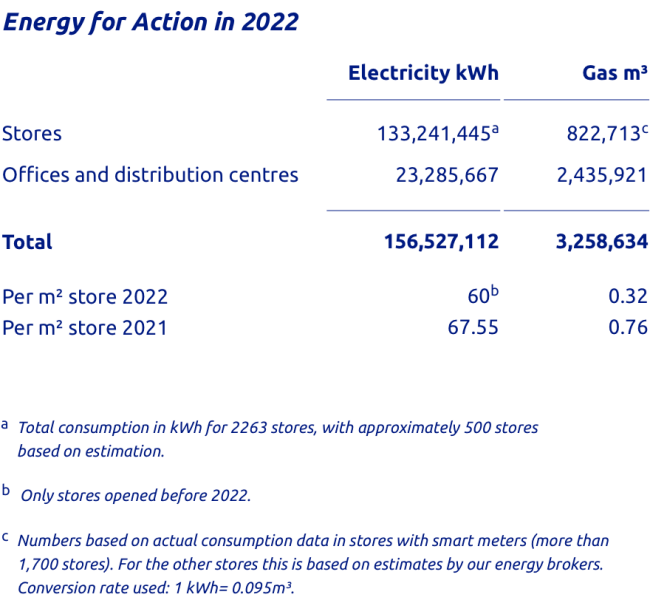
Lowering our energy use
Action also took another step in the reduction of usage by installing energy efficient LED-lights. Currently, 95% of our stores have LED-lights (2,206 stores) and the other 5% will get LED lights at the start of 2023. Moreover, more than 1,700 stores are now connected with smart meters to our energy portal, which will help us to analyse our consumption data and to optimise our usage in 2023.
Hajir Hajji and Edward Stigter
Action commissions 12,700 solar panels at IHQ/DC Zwaagdijk

Read more
Solar panels DC Zwaagdijk
On Friday 23 September, Action CEO Hajir Hajji commissioned a solar roof comprised of almost 13,000 panels at the IHQ/distribution centre in Zwaagdijk-Oost alongside Edward Stigter, Deputy Minister for the Environment and Climate in the province of Noord-Holland, the Netherlands.

Action started in 2022 with mapping its total scope 3 emissions, from raw materials to end-of-life treatment of products. After validation of the data by an external party, we will use the results to determine CO2 reduction targets for scope 3 and to formulate a scope 3 reduction strategy.
Next steps
In 2022, Action decided to implement HVO for all our own trucks (150) that deliver to stores from our Dutch DCs. We decided to install a ‘home-base’ solution in our DCs. Unfortunately, the permit process has taken longer than anticipated, and the installation lead times have been delayed. We expect a full roll-out in 2023.
We have also planned to install solar panels on the roofs of five stores in Austria. We are currently working on the expansion of the number of solar panels on stores, often in consultation with our landlords. In 2023 we will install solar panels on the roofs of our DCs in Ensues-la-Redonne in France, Zakroczym in Poland, and Novara in Italy.
We aim to increase the use of green electricity to 95% for the total of our stores, DCs, and offices, and to reduce energy consumption in stores by at least another 5% per m2. This will be achieved mostly by optimizing the settings of heating, ventilation and air conditioning (HVAC), improving insulation of stores (where applicable), adjusting light settings to store opening hours and analysing the smart meter data of high consuming stores. All this will contribute to our target to reduce energy consumption in our stores by 15% per m2 by 2024 versus the 2021 baseline.
In addition, we are in the process of calculating our scope 3 emissions and determining our targets and reduction strategies.
Remaining targets
Monitoring and evaluation
Action monitors and calculates its CO2 emissions according to the Greenhouse Gas protocol (GHG-protocol). The GHG-protocol is the most recognised and accepted method to calculate emissions. It is a required benchmark to comply with regulations for non-financial reporting (CSRD) and sustainability reporting standards GRI and SASB. In our calculations and communications, we use both ‘Emissions’ and ‘CO2 equivalent emissions’. Both also include other greenhouse gasses such as methane and HFCs, not only CO2.
In 2022, Action set a new CO2 emission target: reduce scope 1 and 2 by 60% by 2030 relative to the 2021 baseline. The CO2 emissions of the previous baseline year (2020) were only calculated for scope 1 and 2. By changing to 2021, we are able to add scope 3 to the baseline calculation, as 2021 is a more recent year, with better availability (completeness and quality) of data. The actual emissions for scope 1 and 2 in the new baseline year 2021 are higher than in the previous baseline year 2020 (47,631 ton versus 44,414 ton). By simultaneously increasing the reduction target from 50% to 60%, our total CO2-reduction task is getting bigger, and the remaining CO2 emissions in 2030 lower.
We collaborate with all relevant partners like landlords, transport truck manufacturers, installing companies, building companies and energy providers to realise our ambitions to reduce absolute emissions from our own operations.
The role of stakeholders
Waste management and recycling

Continue reading
Action’s waste strategy is focused on the correct separation of current waste streams and reducing remaining residual waste. This means that better standardisation of the sorting process is needed in our DCs and training of our employees, especially in the Returned goods department. Our ambition is to start annual audits with business partners on waste processing.
TCFD results

Continue reading
Action is now at the beginning of a journey to deepen the understanding of, and response to, climate change. This year we started working with the framework from The Taskforce on Climate-related Financial Disclosures (TCFD) to embed climate-related risk in our ASP strategy.

Product
Next page
